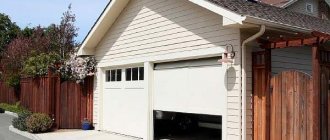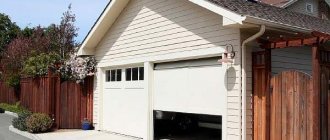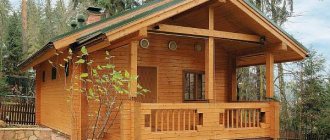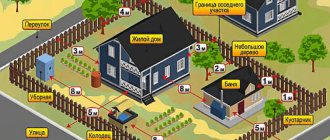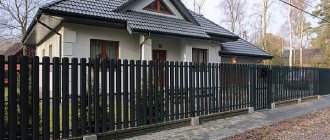When building a garage for a car in a residential area or personal plot, many rules should be taken into account. It is important to understand at what distance from the fence you can build a garage so that there are no problems with neighbors. It is necessary to establish a list of permits for the construction of this type of structure in advance. This will avoid problems with the sale of a garage near the fence due to violation of distances in accordance with construction legislation (SNiP), fire standards and legal requirements.
Rules and regulations
Objects erected on the site cannot violate construction standards (SNiP, SP) that define technical and legislative requirements in the field of architectural and urban planning.
To be able to register a new construction project as part of real estate, you must obtain permission.
In many cases there are exceptions to this rule:
- The idea of building a garage is not related to the desire to make money by renting it out, repairing cars or other things.
- The RV will also be located on owner-owned land zoned for residential development or a non-profit horticultural operation (gardening or roofing cooperative).
- The machine box does not have a foundation, such as a metal one. Therefore, it does not apply to capital construction projects.
In all other cases, the homeowner must submit an application to the architectural department of the municipal government, providing the following documents.
- a written request with mandatory data (from whom, to whom, circumstances and nature of the request);
- Certificate or document confirming land ownership
- a copy of the identity document of the owner of the land plot;
- basic topographic reference to the area;
- technical documentation with expert information from the technical inventory department
- general cadastral plan of the house and surrounding area;
- diagram of communications on the territory of the house;
- system.
After accepting the application, the official must issue the applicant a receipt of acceptance of the documents. A decision on the possibility of constructing a garage in the desired location is issued within ten working days. In practice, this procedure takes longer.
In case of a negative decision, the documents must be returned in accordance with the list. The applicant has the right to reapply to the same authority after a change in the construction plan or can go to court to challenge what the applicant considers to be an administrative refusal.
Conditions for building a garage
According to existing legislative norms specified in the Land Code, a separate permit is not required for the construction of a garage on your own land plot. Unless the owner intends to use it to earn additional or main income.
A special permit will also be required if the land does not belong to the owner, but is part of the territory of a garden cooperative.
According to the new rules, a capital structure must be registered. This is not a mandatory, but desirable measure that is taken in the interests of the owner of the site. After all, in the absence of registration of a capital structure, he may encounter certain obstacles if he wants to sell the plot and dispose of it at his own discretion.
Minimum distance to the border of the neighboring plot
The norms of legislative law, after making adjustments, do not require permission to build a box or structure made of sandwich panels, which are easy to dismantle. Citizens who do not register a building in order to avoid paying taxes on it risk being fined for tax evasion and non-payment.
In order to obtain permission for construction, it is enough to simply contact the appropriate authorities. It is necessary to provide a site plan along with the application, which will indicate the proposed construction location.
After checking for compliance with existing standards, a permit will be issued for the finished premises, provided that it is located at a distance from other objects specified in the standards. Among these standards is the distance between the fence and the garage.
Although construction standards are taken into account on the basis of SNiP and SP, they do not have legislative force. The land owner may ignore the relevant requirements. But this can bring him significant inconvenience if:
- there will be a need to sell the house and buildings;
- you will have to register the building or house;
- neighbors will have complaints, and they will go to court (and the court, in considering such complaints, is guided by the norms specified in the code of norms and rules of civil engineering);
- an appeal regarding a building may be the issue of its location from the neighbors’ fence: the possibility of damage to the fence, covering with shadow a part of the land intended for planting;
- new neighbors discovered a violation, and the established three-year statute of limitations on the construction had not yet expired.
Standards for distance from buildings and boundaries of neighboring plots
Obtaining a building permit largely depends on whether the design of the object complies with the provisions of SNiP, and in particular, whether the minimum permissible distances from courtyard objects, adjacent buildings and infrastructure are observed during the construction of the garage.
The provisions of SNiP 1997 and SP 53.13330.2019 require that outbuildings, including premises for passenger cars, be as follows:
- 3 meters from residential buildings if the garage is attached;
- distance to other outbuildings (barn, separate attic, etc.) from 1 m;
- distance from the fence to the garage - 1 m;
- at least 1 meter to the bush;
- distance from trees of average height 2 meters;
- the distance between the outbuilding and tall trees is 4 m;
- the distance from the neighbor’s house is at least 6 meters;
- to the “red line” (the border of a private house and city land) more than 5 m.
Please note that a garage cannot be built next to a fence, as shown below:
- The distance from the neighbor's fence should be 1 meter.
- If there is no fence, a distance of 1 meter from the border of the neighboring property should be provided.
Subtleties
Significant restrictions on the specific location of the car box and the functioning of its individual structural elements:
- If a garage is attached to the house, the distance to the nearest building must be at least 3 meters.
- If the garage is located at a gate facing the street, stay 3 meters away from the road.
- In villages and cities, the minimum distance between the garage and the road is 5 meters, and this distance is calculated from the base of the building or roof if its protrusion exceeds 0.5 meters.
- If one side abuts a neighbor's fence rather than his driveway, the distance from the road should be less than 3 meters.
- Installation closer than 2 meters from a power line support is not allowed.
Violation of the provisions of SNiP in the case of unauthorized construction is not grounds for initiating an administrative or criminal case. But the initiation of a complaint by a neighbor or an examination of the consequences of an emergency situation caused by an attached house will lead to a court decision precisely in accordance with SNiP.
Standards for individual housing construction and SNT
Before purchasing land outside the city, it is important to find out its economic purpose. The possibility of laying communications and using the site within the framework of achieving the set goal depends on this. So, if the land is intended for individual housing construction (the height of the building is limited to 3 floors), then when installing a fence or building a house, the same rules are followed as in the case of buildings located within the city.
Dacha owners are limited in how they can exploit the land. Without permission from the SNT board, they are not allowed to build a barn for raising poultry or livestock. But you can build a bathhouse and a shed for equipment, lay a water supply and sewerage system. You can build on no more than 30% of the total area allocated for a summer cottage. The height of the fence should not exceed 1.5 meters. The standards for SNT are:
- 3 m between the dacha and the fence, and the fence must be transparent;
- 15 m are left between the dacha and the wooden barn;
- from the street to the house – 5 m;
- poultry houses and barns 4 m from the fence.
For individual housing construction, the standards are as follows:
- from the toilet to the housing – 12 m;
- from the house to the bathhouse - 8 m;
- poultry house, barn, cesspool - 12 m.
Plants are planted at a distance of 1 meter from the fence.
Fire regulations
Fire safety rules are specified in:
- SP 55.13330.2016;
- SP 1.13130.2020;
- SP 4.13130.2013;
- SP 2.13130.2020;
- Fire regulations in force in accordance with Decree of the Government of the Russian Federation No. 1479.
Current changes are regularly made to the submitted documents (standards).
When and why were the standards for indentation from the boundaries of a land plot invented?
Information about the size of the setback from the boundaries belonging to a citizen of the land can be found in various laws on fire and sanitary safety. The norms discussed in these documents were developed in the middle of the 20th century, but they were invented and began to be observed much earlier. The reason is basic safety. During a fire, the fire could easily spread to a house belonging to a neighbor; a fence installed by the same neighbor could prevent people from quickly evacuating the burning building.
Minimum offsets from the red line
The above-mentioned outline of the building line is an important factor in determining the feasibility of construction in the selected location.
Lighting poles, information signs, etc. Usually located in public places near private homes.
Main gas, water and sewerage are hidden underground. They are connected to footpaths and in many cases also to motorways and local roads.
Construction restrictions allow the public unlimited 24-hour access to the lifeline. The general plan (GPZU) of each city indicates the exact location of the red lines. If the documentation submitted for approval is shorter than 5 m from the box, we will likely receive a negative answer.
It is likely that if a building is built without taking into account the distance to the red line, the owner will have to demolish it by court order.
How to arrange buildings inside the site
Before construction begins, it is necessary to draw up a site plan showing the location of the residential building and outbuildings. The basic law regulating the construction of facilities on the site, SNiP 30-02-97. Here are recommendations aimed at ensuring the safety and health of people. Construction standards indicate at what distance objects can be built inside a summer cottage:
- A toilet with a cesspool, a barn for poultry and small livestock should be located no closer than 12 m from a residential building and cellar.
- A septic tank, toilet, and compost heap are installed at a distance of more than 8 m from the well.
- Shower, bath, sauna - at least 8 m between them and residential buildings and cellars.
Permissible distance between buildings within the siteSource o-nedvizhke.ru
If the utility block with animals and the residential building are adjacent, the entrances are arranged separately and spaced at a distance of at least 7 m from each other.
Subtleties of construction next to wooden buildings
Neighborhood with a wooden house increases the required distance to 15 meters. The right to reduce this distance with the owner is reserved. The agreement must be concluded in writing and notarized.
The same procedure for neighbors also applies to a brick house, if the construction distance is less than 6 meters. The condition for receiving a positive response from a neighbor is the introduction of sufficient fire safety measures.
It requires:
- install the outer casing with recommended fire-fighting accessories;
- place a fire extinguisher in the room;
- Make sure the room is not heated;
- The electrical panel must be located outside the building;
- The electrical panel must be equipped with a circuit breaker;
- lay the wires in a protective metal sheath;
- The lamps are equipped with factory lamps.
Failure to follow the above recommendations may not only lead to the loss of the settlement agreement, but also worsen the entire situation.
So, following Art. 304 of the Civil Code of the Russian Federation, the owner of an adjacent property may require compliance with fire safety rules during its construction and operation. Failure to comply with permissible building distances creates a direct possibility of fire spreading.
✅ Recommended distances
In accordance with Art. 10 of the Civil Code of the Russian Federation, owners cannot use their own rights to the detriment of other persons. This means that the garage box should not:
- shade the neighboring area, reducing the quality of lighting for garden beds and garden trees;
- interfere with the elimination of the consequences of a fire, earthquake or other emergency situations.
Water should not flow out to the neighboring area - the roof should not hang over it. The minimum permissible distance from the edge of the roof to the neighbor’s fence is 1 m . This distance is allowed provided that there is no building located near the fence on the neighbor’s side. It is not recommended to build a garage close to a neighbor's house. If the residential building is made of wood, then the recommended distance is 15 m , if it is made of brick - 6 m .
Measurements are taken from the point of the roof closest to the adjacent site, and not from the facade of the building. They are performed using a regular construction tape measure. It is not recommended to use electronic measuring instruments, since errors may occur due to weather conditions or insufficient operator qualifications. Mistakes will lead to disputes between neighbors in the future.
If the owners of neighboring plots can come to an agreement, the garage can be built closer than 1 m from the fence. This must be reflected in a document drawn up and signed by the interested parties. To avoid disagreements and challenge the legality of the document, it is worth taking care of notarization of the act. If the owner of the site changes, then the agreement should be drawn up again (if the statute of limitations of 3 years has not expired, then claims from the new owner are possible).
Where is the best place to build?
To avoid problems with documentation approval by local architects, the construction of a caravan should be planned according to the following rules:
- If the building is located in a courtyard, the entry of vehicles prohibits additional maneuvers.
- There should be enough space inside the entry gate so that the garage door can be closed.
- A garage entrance, if adjacent to a road, must be designed to provide sufficient visibility for the safe maneuvering of exiting vehicles.
- Opening the gate should not interfere with the movement of pedestrians and passing vehicles.
- The building cannot block the access of light to the neighbor’s vegetable garden or garden if low-growing tree species grow in it.
- The drainage of water from the roof must be directed to its own site in a protected area or KVP either from the roof or through the ground through a ditch.
- Plant your own trees in accordance with SNiP (SNiP).
- If you decide to build a garage or basement next to your house, you must follow all fire safety rules. They concern the equipment of room hoods, fire-fighting equipment and fire alarms.
If the garage is located in a private house on the ground floor, fire safety regulations allow parking and storage of liquid fuel vehicles there.
Garage dimensions
When planning a garage, calculate the dimensions of the garage so that it is as comfortable and safe as possible for use. They can be:
- on both sides of the car - 0.75 m;
- if there are pillars, at least 0.5 meters;
- at least 0.6 meters on the side of the trunk and hood of the car;
- for large parking spaces, when cars are parked one after another - 0.5 m;
According to SNiP, ceiling height is the distance from the surface of the floor covering to the maximum protruding lighting fixture or communication element. The safe distance in relation to the vehicle must be at least 0.2 m.
Compliance with these recommendations will allow you not only to comfortably use the room for its intended purpose, but also in emergency situations.
For example, in the event of a fire, this will help evacuate cars and contain the spread of fire.
About garage sizes
The dimensions of the building are determined by the number of vehicles and their sizes. Since the allotment area is not that large, they try to minimize the size of the garages:
- There should be at least 50 cm of free space behind and in front of a parked vehicle. This means that the minimum length of the building is equal to the sum of the length of the car and 1 m.
- The width includes the width of the car plus 90–100 cm on each side for the doors to open freely.
- There is at least 50 cm between the ceiling and the roof of the car, that is, the value is equal to the sum of the height of the car and 50 cm.
Often in the garage you need to provide space for bicycles, mopeds, and hoverboards. If a motorcycle is also placed in the box, the width of the garage increases noticeably.
How much do you need to step back from the fence when building a garage?
In towns and villages, situations often arise with simple solutions, including:
- The owner built a garage next to the fence and doesn’t know what to do. The best solution is to comply with all fire preparation requirements and negotiate with your neighbor, making sure there are no documented objections.
- What to do if a neighbor has placed a garage on the side of the fence, without retreating, violating the 1 meter rule, and the sidewall is flush with the fence? If the construction was carried out without permission, it is necessary to file an application with the court.
- How far should you stay from your neighbor's house if it is wooden and there is no fence on the property? Follow the recommended norms - 15 meters. If you want to build a brick or iron garage in a neighboring house, you can get the owner's permission.
- How far is the garage from the fence if the red line is 9 meters? With such a distance from the property line of the land plot, the minimum distance between the garage and the fence by law must be at least 1 meter.
- The occupancy of the house after the purchase occurred later than the time when the neighbor built a garage, it turns out that the distances are respected, and there is no light in the yard. A yard is not a vegetable garden or vegetable garden. Distances have been maintained, and there is no need to initiate a case. In this case, all that remains is to remake your plot as much as possible.
Every year the country's legislation improves and SNiP requirements change. Accordingly, advice from practitioners should be sought to obtain objective information on a case-by-case basis.
This also applies to situations when we have difficulties preparing a project for a future garage on our own site or in a country estate.
The following video shows how many meters you need to go back to place a free-standing object on the site.
Fire safety rules
To prevent the spread of fire in the event of a fire, the distance between buildings should be 5 m, and between buildings in adjacent areas - 3 m.
It is important to consider that when the garage is attached to the house, the distance from the neighboring house is 3 m.
Another design point is that with an estate area of up to 12 acres, SNT (garden partnerships) and cooperatives are allowed to use only 30% of the estate for construction. In this case, a built-in garage is very relevant.
According to fire standards, all structures are divided into several safety classes. The key factor here is the materials from which they are made.
For a detailed description of fire regulations, classification of buildings, and distance standards, read the article: “At what distance from a neighbor’s fence can you build a house.”
Issue resolution and judicial practice
This is a last resort in cases where it is not possible to find a common language. But if you can't get rid of your land to build a garage because of unfounded claims, there is no other way to prove your case.
At the court hearing, the plaintiff prepares and files a claim and attaches residential documents defining ownership. The list duplicates the necessary documents for approval of the project by the administration architects.
The plaintiff indicates the circumstances and subject of the illegal claim, as well as the means and methods of preventing the exercise of rights to a garden plot or a private house. Evidence of the case in the form of photos and videos is attached to the statement of claim.
Before drawing up a statement of claim, you must make sure that the plaintiff does not violate the law and that the distance standards from residential and utility premises are observed.
Otherwise, it will be impossible to make a positive decision.
Legal claims
Domestic disagreements between neighbors are not uncommon. It is difficult to find mutual understanding on certain issues related to the placement of individual buildings. For example, what to do if a neighbor built a garage close to the fence and does not want to ensure the level of fire safety. The other side of the issue is when the owner of an adjacent plot makes unfounded claims against the homeowner regarding his fence.
If the distance from the fence to the garage and other buildings is maintained by the owner of the property, but the neighbor voices constant unfounded claims, he should be invited to familiarize himself with the requirements of SNiP or file an application with the court as the last resort in resolving controversial issues under the law. Before the court hearing, it is useful to determine whether the neighbor has violated the established building codes. If so, then filing a counterclaim will cool the ardor of the initiator of unfounded claims.
Norms
It should be remembered that a settlement of any organizational form (for example, a village, a village, a city, an urban settlement) is built in accordance with the requirements of SNiP and the recommendations of regional authorities. They apply to all owners of plots in these territories.
The plaintiff, that is, the person whose rights have been violated, files a claim in court. It should indicate the subject of the claims against the defendant and the grounds, for example, SNiP requirements, fire or sanitary violations, non-compliance with the housing code. Attached to the application, in addition to a copy of the passport, are title documents for the house and land, photographs or video materials of the violations committed.
Before submitting an application, it is recommended to make sure that there are no violations of SNiP on the part of the initiator himself and that the distance from the neighbors’ fence is maintained. If they exist, especially with additional extensions to houses, it is quite possible to receive counterclaims instead of a positive decision.
Suburban area
In conclusion
If the homeowner maintains the distance from the garage to the fence or property line and other elements on the property, unclear stakeholder claims can be resolved by taking control measurements.
This data will be enough to prove the case in any court. It will also be possible to defend your rights in case of violation by neighboring landowners in the village or in the private sector in the village.
Legislative regulation of the placement of fences
For many people who have recently become owners of land plots, it is a revelation that even being on their own territory, they cannot place buildings as they please. The location of buildings, structures and enclosing structures is quite strictly regulated by relevant legislative acts.
As a rule, design organizations have a complete list of documents - it is for this reason that it is worth contacting them first with planning issues and resolving controversial issues. But even if you do not plan to do construction yourself, the basic SNiPs for the construction of fences and the construction of buildings are worth studying.
Layout of the site and fencing according to SNiPs
The main documents that contain information about restrictions on the construction of fences and fences are:
- SNiP30 – 02 – 97 . These building rules stipulate the procedure for planning private households in gardening partnerships and other similar structures. A separate section of the document is almost entirely devoted to the distances from adjacent fences to various objects.
- The SP 11 – 106 – 97 standard regulates the process of developing design documents for private houses. This set of rules is more complex and there are several controversial issues in its interpretation, but it is worth having it at your disposal and, if necessary, consulting it.
SNiP for fences is a document whose requirements are highly desirable. The reason for this approach lies in the fact that if the requirements are violated, either your neighbors or the administration of the locality in which the private household is located may file a lawsuit against you.
And most often, court decisions are not made in favor of the violator, and therefore it is better to protect yourself in advance than to demolish a building or completely reconstruct a fence as part of the implementation of a court decision.
Note! In addition to the requirements contained in SNiP for fences, there are also local regulations. They must be taken into account, but in this case negotiations will have to be conducted with the administration of the locality.
Is it possible to build a garage on the border of the plot?
Often in old houses you can find this arrangement. Moreover, garages can also be double, when neighbors decide to build a joint building on the boundary dividing line. This is a good option that “works” only in the case of cloudless relations between neighbors, as well as a joint distribution of responsibilities for maintaining the structure.
Technically, this arrangement is possible, but there are some nuances. First of all, this is the written consent of the second party about the location of the building on “common” land. Even if it is received, do not forget about the possibility of force majeure.
“Pitfalls” of this option:
- The neighbors' written consent must be renewed every three years. After this period it is considered invalid.
- When the owner of the neighboring plot changes, the contract is automatically canceled, and it is still unknown whether the new owner will agree to such a decision.
- The heirs or even the significant other of the owner of the neighboring plot also have the right to terminate such an agreement.
- Structural changes to the architecture of the garage must also be agreed upon with the owner of the neighboring property.
As you can see, the location of the garage on the border of the site is fraught with troubles. In addition to legislative rules, there is a risk of being drawn into proceedings simply because relations between neighbors have deteriorated or any modernization of the premises will become impossible.
Construction documents
The flexible system of legislation does not regulate exactly what must be provided before building your own garage. The best option is to find an intelligent architect associated with this field. Regulations may change even depending on the region of residence, so it is impossible to provide exact advice and instructions.
The following points can be highlighted:
- The construction of a garage on the site of an old structure already included in the technical passport does not require registration again.
- Modernization and any design changes must be agreed upon and also secured at the legislative level.
- The construction of a new residential and utility structure, as well as the installation of fences, requires familiarization of all neighbors and their written consent with your plan. If someone disagrees, this opinion must also be taken into account.
- Controversial issues regarding the placement of boundary boundaries and corresponding buildings must be resolved with the involvement of geodetic services.
- The simplest, but most expensive way is to order the layout of structures from an independent architectural organization. Of course, this will help solve many problems, but the cost of such services will be very significant.
- If construction work is underway on your property and on your neighbor’s property at the same time, it is important to agree on the location of the new facilities with the owner of the neighboring property. It would be a good idea to consolidate such agreements in a written agreement so that problematic issues can be challenged in the future.
This is probably the most difficult part of the future garage construction project. Often such litigation drags on for a long time, especially when it comes to controversial issues between the owners of neighboring plots. In this case, our advice can help, as well as compliance with basic standards for the placement of outbuildings on the site.
